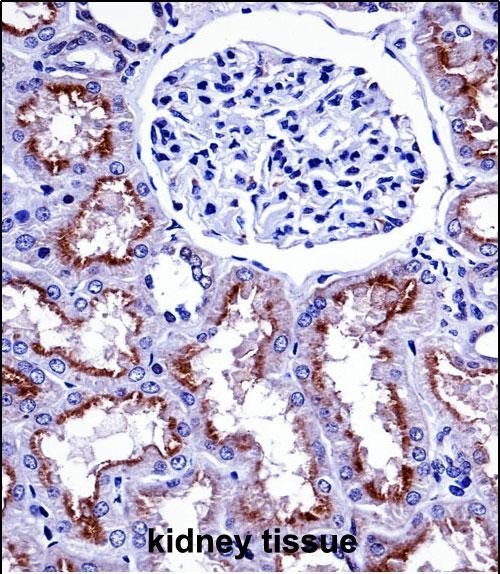NOX4 Antibody (N-term)
Affinity Purified Rabbit Polyclonal Antibody (Pab)
- 产品详情
- 实验流程
- 背景知识
Application
| IHC-P, WB, E |
|---|---|
| Primary Accession | Q9NPH5 |
| Other Accession | NP_001137308.1, NP_058627.1 |
| Reactivity | Human |
| Host | Rabbit |
| Clonality | Polyclonal |
| Isotype | Rabbit IgG |
| Calculated MW | 66932 Da |
| Antigen Region | 124-153 aa |
| Gene ID | 50507 |
|---|---|
| Other Names | NADPH oxidase 4, 163-, Kidney oxidase-1, KOX-1, Kidney superoxide-producing NADPH oxidase, Renal NAD(P)H-oxidase, NOX4, RENOX |
| Target/Specificity | This NOX4 antibody is generated from rabbits immunized with a KLH conjugated synthetic peptide between 124-153 amino acids from the N-terminal region of human NOX4. |
| Dilution | IHC-P~~1:100~500 WB~~1:1000 E~~Use at an assay dependent concentration. |
| Format | Purified polyclonal antibody supplied in PBS with 0.09% (W/V) sodium azide. This antibody is purified through a protein A column, followed by peptide affinity purification. |
| Storage | Maintain refrigerated at 2-8°C for up to 2 weeks. For long term storage store at -20°C in small aliquots to prevent freeze-thaw cycles. |
| Precautions | NOX4 Antibody (N-term) is for research use only and not for use in diagnostic or therapeutic procedures. |
| Name | NOX4 |
|---|---|
| Synonyms | RENOX |
| Function | NADPH oxidase that catalyzes predominantly the reduction of oxygen to H2O2 (PubMed:14966267, PubMed:15356101, PubMed:15927447, PubMed:21343298, PubMed:25062272). Can also catalyze to a smaller extent, the reduction of oxygen to superoxide (PubMed:10869423, PubMed:11032835, PubMed:15155719, PubMed:15572675, PubMed:15927447, PubMed:16019190, PubMed:16179589, PubMed:16230378, PubMed:16324151, PubMed:25062272). May function as an oxygen sensor regulating the KCNK3/TASK-1 potassium channel and HIF1A activity (PubMed:16019190). May regulate insulin signaling cascade (PubMed:14966267). May play a role in apoptosis, bone resorption and lipolysaccharide-mediated activation of NFKB (PubMed:15356101, PubMed:15572675). May produce superoxide in the nucleus and play a role in regulating gene expression upon cell stimulation (PubMed:16324151). Promotes ferroptosis, reactive oxygen species production and reduced glutathione (GSH) levels by activating NLRP3 inflammasome activation and cytokine release (PubMed:39909992). |
| Cellular Location | Cytoplasm. Endoplasmic reticulum membrane; Multi-pass membrane protein. Cell membrane; Multi-pass membrane protein. Cell junction, focal adhesion {ECO:0000250|UniProtKB:Q924V1}. Nucleus [Isoform 3]: Cytoplasm. Cytoplasm, perinuclear region [Isoform 6]: Cytoplasm. Cytoplasm, perinuclear region |
| Tissue Location | Expressed by distal tubular cells in kidney cortex and in endothelial cells (at protein level). Widely expressed. Strongly expressed in kidney and to a lower extent in heart, adipocytes, hepatoma, endothelial cells, skeletal muscle, brain, several brain tumor cell lines and airway epithelial cells |
For Research Use Only. Not For Use In Diagnostic Procedures.
Provided below are standard protocols that you may find useful for product applications.
BACKGROUND
This gene encodes a member of the NOX-family of enzymes that functions as the catalytic subunit the NADPH oxidase complex. The encoded protein is localized to non-phagocytic cells where it acts as an oxygen sensor and catalyzes the reduction of molecular oxygen to various reactive oxygen species (ROS). The ROS generated by this protein have been implicated in numerous biological functions including signal transduction, cell differentiation and tumor cell growth. A pseudogene has been identified on the other arm of chromosome 11. Alternative splicing results in multiple transcript variants.
REFERENCES
Bailey, S.D., et al. Diabetes Care 33(10):2250-2253(2010)
Salmeen, A., et al. Oncogene 29(31):4473-4484(2010)
Wu, R.F., et al. Mol. Cell. Biol. 30(14):3553-3568(2010)
Diebold, I., et al. Mol. Biol. Cell 21(12):2087-2096(2010)
Manea, A., et al. Biochem. Biophys. Res. Commun. 396(4):901-907(2010)
终于等到您。ABCEPTA(百远生物)抗体产品。
点击下方“我要评价 ”按钮提交您的反馈信息,您的反馈和评价是我们最宝贵的财富之一,
我们将在1-3个工作日内处理您的反馈信息。
如有疑问,联系:0512-88856768 tech-china@abcepta.com.























 癌症的基本特征包括细胞增殖、血管生成、迁移、凋亡逃避机制和细胞永生等。找到癌症发生过程中这些通路的关键标记物和对应的抗体用于检测至关重要。
癌症的基本特征包括细胞增殖、血管生成、迁移、凋亡逃避机制和细胞永生等。找到癌症发生过程中这些通路的关键标记物和对应的抗体用于检测至关重要。 为您推荐一个泛素化位点预测神器——泛素化分析工具,可以为您的蛋白的泛素化位点作出预测和评分。
为您推荐一个泛素化位点预测神器——泛素化分析工具,可以为您的蛋白的泛素化位点作出预测和评分。 细胞自噬受体图形绘图工具为你的蛋白的细胞受体结合位点作出预测和评分,识别结合到自噬通路中的蛋白是非常重要的,便于让我们理解自噬在正常生理、病理过程中的作用,如发育、细胞分化、神经退化性疾病、压力条件下、感染和癌症。
细胞自噬受体图形绘图工具为你的蛋白的细胞受体结合位点作出预测和评分,识别结合到自噬通路中的蛋白是非常重要的,便于让我们理解自噬在正常生理、病理过程中的作用,如发育、细胞分化、神经退化性疾病、压力条件下、感染和癌症。







